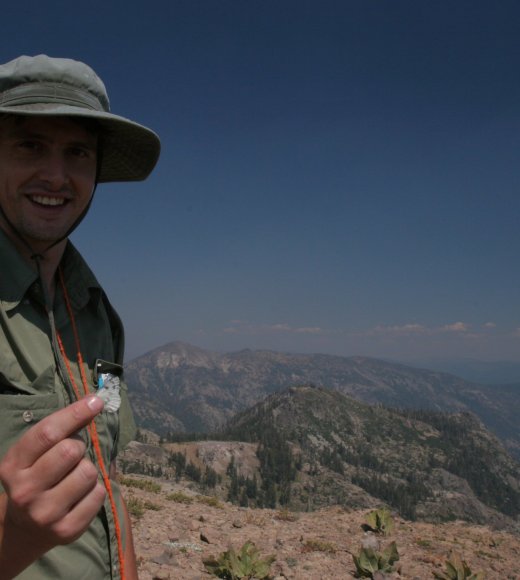
Bio
- Born and raised in the foothills of southern Oregon, I have been chasing butterflies since childhood. I am fascinated by all aspects of natural history. I recieved my B.S. with Honors at the University of Florida in 1999 in Wildlife Ecology and Conservation and minored in Zoology. While at U.C Davis, I have had my hands in many projects.
- My primary Ph.D. research focuses on the evolutionary ecology of the sooty hairstreak species complex (including Satyrium fuliginosum fuliginosum and Satyrium fuliginosum semiluna), especially with regard to apparent loss of the stigma, a male sexual trait used in courtship. I am very interested in processes that promote speciation, especially in genetic, behavioral, and ecological terms. Sooty hairstreaks are also highly "myrmecophilous": the larvae have mutualistic relationships with ants. The larvae have specialized glands that produce a sugary solution which the ants drink. In exchange, the ants defend the larvae from attack from parasitoid wasps and other enemies. The intensity of the relationship is not yet known, although several ants species are involved. This research has strong laboratory and field elements. I am studying genetic relatedness between adjacent populations and am conducting a combination of in-lab mating trials and field-based population recognition experiments using phenotypically and genetically divergent populations. There is a very interesting gradient between populations of Satyrium fuliginosum fuliginosum and Satyrium fuliginosum semiluna in the vicinity of Donner Pass.
- I recently published a comparative phylogeographic study of "weedy" butterflies (especially the Fiery Skipper, the Eufala Skipper, and the Gulf Fritillary) with Art Shapiro and former Shapiro Ph.D. student Matt Forister (now at the University of Nevada, Reno). These "Pan-American" species are found from the southern United States through Argentina, but only really in mowed lawns, urban gardens, and other highly human-disturbed habitats. The motivating question: Where were they before the invention of lawn mowers, and what were they doing? This project also to includes the Funereal Duskywing and three sister species pairs that have non-overlapping ranges in North and South America: 1) Vanessa annabella vs. Vanessa carye, 2) Euptoeita claudia vs. Euptoeita hortensia, and 3) Ancyloxypha numitor vs. Ancyloxyphya nitidula. This work is published in The Journal of Biogeography.
- I have recently completed a multi-year study of how varying levels of cattle grazing intensity affects local butterfly species richness, evenness, and density in the very diverse Cascade-Siskiyou National Monument of southwest Oregon. In short, butterfly diversity was more correlated with local habitat factors (like plant species richness and percent cover) than with cattle grazing intensity, but the abundance of some butterfly species (especially those with grassy host plants) declined at higher levels of cattle grazing.
- In addition to helping construct and edit many aspects of this website, I have been analyzing how life history predicts the yearly abundance of butterflies using the Shapiro data.
